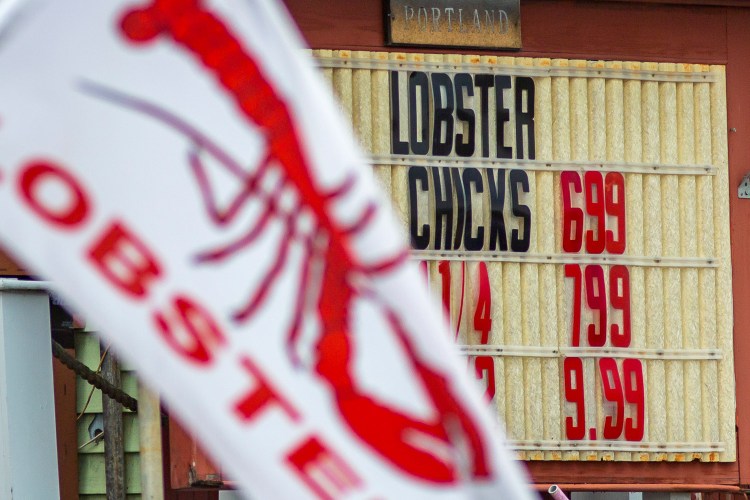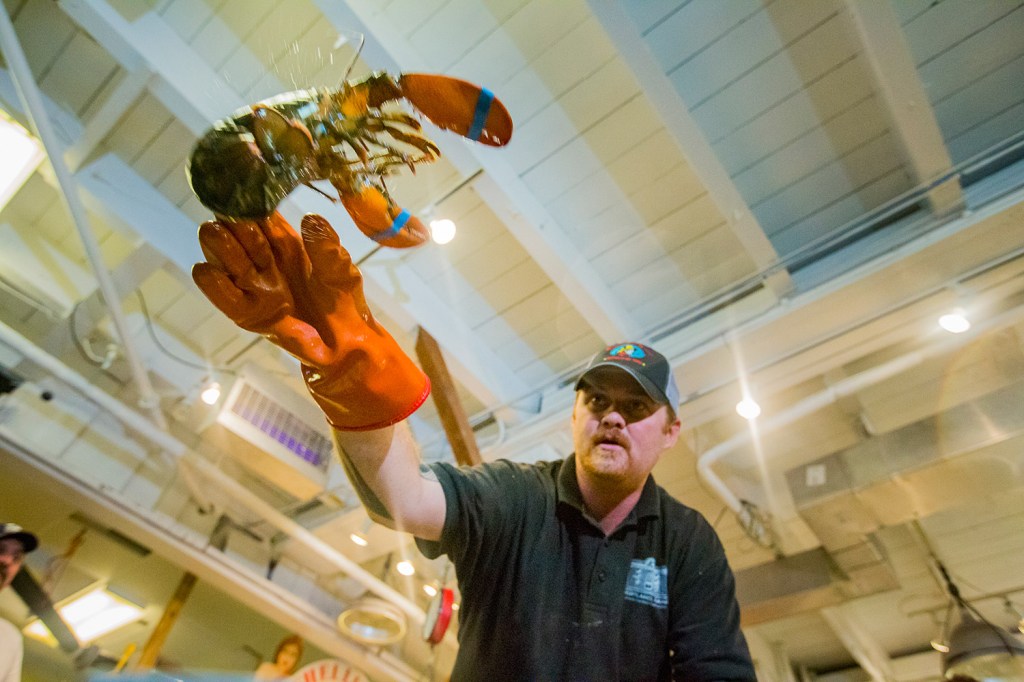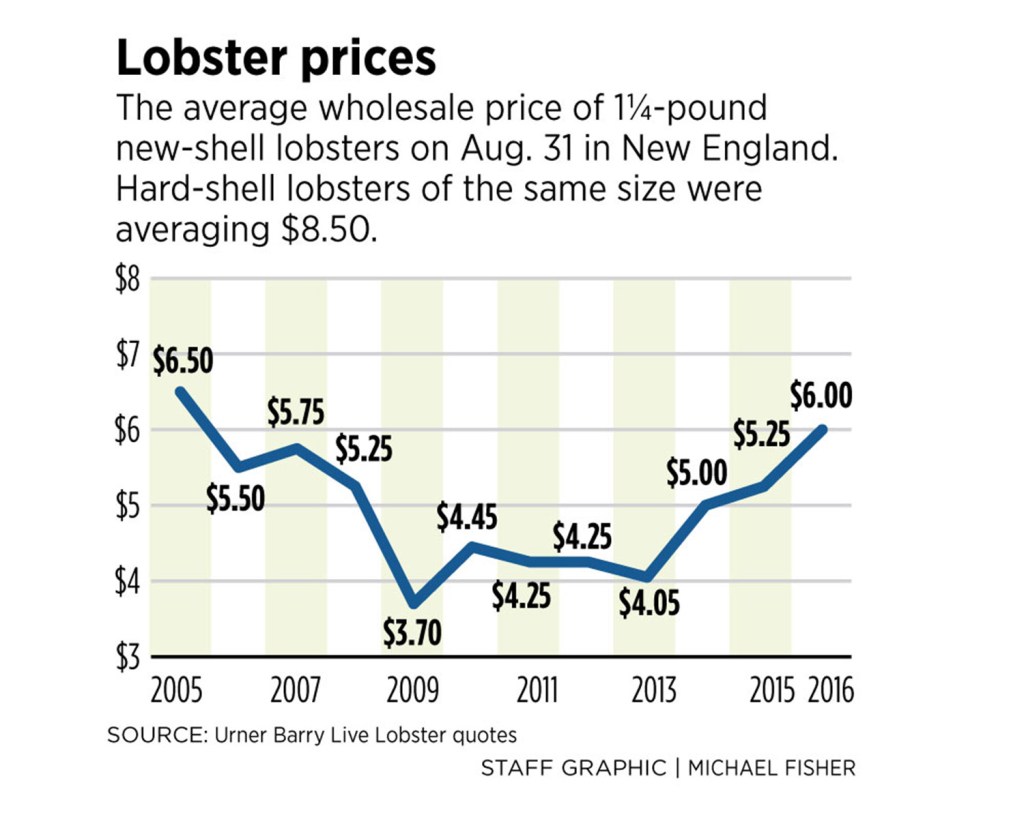Lobster prices in New England have spiked to their highest level in more than a decade, thanks to expanding markets, robust processing activity and anticipated Labor Day weekend demand.
Trade publication SeafoodNews reports that the wholesale price for a 11/4-pound hard-shell lobster reached $8.50 this week, and new-shell lobster reached $6 – the highest August prices since 2005.
The price data, from commodity news reporting service Urner Barry, show that hard-shell prices are up 25 cents from the previous week, and new-shell up 50 cents, as retailers stock up for Labor Day weekend.
SeafoodNews attributed the price spike in large part to growth in the number and productivity of lobster processors in Maine and Massachusetts. It said there are “significantly more companies” engaged in lobster processing, and demand for their products is so high that they continue to compete with live lobster buyers even during periods of high demand such as the week leading up to Labor Day.
In the past, processors avoided buying lobsters during weeks of high demand for fear of driving up prices, it said.
Even at the highest market prices in a decade, consumer demand for lobster remains strong at restaurants in Maine. John Randall, a manager at Portland Lobster Co. on the Portland waterfront, said August was a great month for business and that the restaurant is expecting robust sales over the Labor Day weekend.
“I guess it’s just one of those things that people are willing to pay for, especially if they’re here visiting,” Randall said. “We get a lot of tourists in here. When people come in from Las Vegas, and they see a lobster roll for $16.99, that’s still a lot better than what they can get one for back home.”
‘IT’S BEEN CRAZY SINCE THE FOURTH’
Annie Tselikis, marketing director at Maine Coast Co. and executive director of the Maine Lobster Dealers’ Association, said demand for live and processed lobster has been strong all summer.
“We have seen higher prices in the marketplace this summer … on par with the demand that we’re seeing,” she said. “It’s been crazy since the Fourth of July.”
Tselikis said a big reason for the boost in demand for processed lobster is that distributors have stepped up their efforts to create new markets. Much of the recent growth in demand has come from Asian markets including China, South Korea, Hong Kong, Singapore and Vietnam, she said.
“We’re seeing lobster in places where it didn’t exist before,” Tselikis said.
Through creative marketing, the industry also has boosted demand for lobster products in countries that already were accustomed to live lobster and lobster rolls by convincing retailers and restaurants that lobster can be used in a much wider variety of foods, she said.
Major grocery and restaurant chains have begun to offer more lobster-based products, and consumers now expect to see lobster on the menu at places where they didn’t before.
“They’re getting creative with how they’re using lobster, and using it as an ingredient in a dish,” Tselikis said.
In a way, today’s high demand for lobster is the result of a recent crisis in the industry.
In 2012, the industry was dealing with a glut of the new-shell lobsters – those that have shed their shells and are growing new ones – and a shortage of buyers that combined to create historically low prices for Maine’s iconic catch.
Lobsters were selling for $2.25 to $2.50 a pound at the dock, the lowest prices buyers had seen in decades. The average wholesale price for a 1-1/4 pound lobster, which incorporates packaging and storage costs, was about $4.25. The situation prompted lobster companies to innovate and push their way into new markets, Tselikis said.
“They generated a considerable market expansion, and we’re still seeing that,” she said.
‘GOING ALL OVER THE WORLD NOW’
Expanded markets in Asia could soften the impact of a potential ban by the European Union over concerns from Swedish scientists who want American lobster classified as an invasive species that threatens their native lobster populations. A decision on whether to classify American lobsters as invasive is expected this month.
Innovations in freezing, processing and packaging also have helped the industry by making it more economically feasible to ship lobster – even live lobster – to more distant overseas markets, said Scout Wuerthner, sales manager of the lobster division at Inland Seafood in South Portland.
“Lobsters are going all over the world now,” he said. “The last five or six years when the catch came on really strong, we were forced to do that.”
Inland ships live lobsters by truck to areas such as New Orleans and Houston, where some go on to Europe, Asia and other parts of the world. Thanks to innovations in shipping methods, it’s possible to ship lobsters 40 to 50 hours and have them arrive at their destination alive and intact, Wuerthner said.
But that doesn’t mean it’s easy.
“It’s a tough business,” he said. “It’s very competitive. It’s 24/7, because you’re shipping live lobsters all over the world.”
CORRECTION: This story was updated at 10:52 a.m. on Sept. 2, 2016 to change dock price to wholesale price.
Send questions/comments to the editors.






Comments are no longer available on this story